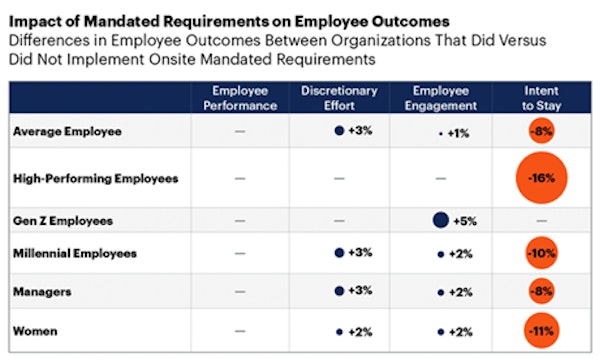Why a rigid return to the office will drive high performers away
More companies are enforcing rather than encouraging a return to the office. That’s a bad idea, according to new Gartner research, because it will drain organisations of their top talent
As more companies mandate their employees back to the office, new research from Gartner suggests that such a rigid return policy might not be a good idea – the highest performers in the organisation are the most likely to head straight for the door.
Gartner surveyed 2,080 knowledge workers on their intent to stay in their jobs if strictly mandated to return to the office. High performers were twice as likely as the average employee to quit their jobs. Women and millennials were also a flight risk.
According to Caitlin Duffy, Director in Gartner’s HR Practice, ‘Mandated on-site requirements can carry very steep costs for talent attraction and retention. This is especially true for high performers, women and millennials – three employee segments who greatly value flexibility.’

Image: courtesy of Gartner
What leaders want
In a further Gartner study of nearly 3,500 employees, nearly half of those surveyed (48 per cent) said that their company’s return to office (RTO) mandates prioritise what leaders want as opposed to what employees might need to do a good day’s work.
Office mandates have been imposed by corporate HR departments following low rates of compliance with policies that encourage a return to the office rather than enforcing it. However, stricter policies clearly come at a cost. High performers who have proven themselves in the organisation experience a loss of trust. Female employees struggle to balance work and life. Millennials craving flexibility (often because they have care-giving responsibilities) chafe against inflexible rules.
As the risks of RTO mandates can outweigh the benefits of in-person collaboration and culture-building, Gartner has identified four best practices HR leaders should consider:
- Motivate employees to return to the office rather than mandate. Organisations can motivate employees to come to the office by designing their office space and hybrid policies to make employees feel capable, autonomous and connected.
- Consider policies that focus on-site attendance per year, not per week. Gartner research found that organisations mandating a minimum number of in-office days per year achieve greater employee performance than those mandating a minimum number of in-office days per week.
- Enable employees to shape the RTO policy. Employees who contributed to their teams’ hybrid work arrangements and felt like their needs were considered demonstrated both higher engagement and work performance.
- Provide a clear reason behind requirements for working on-site. Organisations that transparently communicated their reasons for wanting employees to come into the office saw positive impacts on engagement, discretionary effort and retention.








